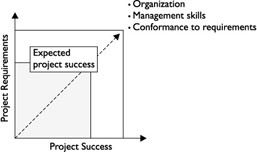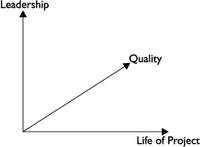Quality of the Process
Whether you are creating a product or a service, you will follow a process to arrive at the deliverables. As you ve read in all of the earlier chapters, there is a set process, a logical and discrete order of getting a project from start to finish. The project management framework from initiation, planning, execution, control, and closure of each phase is guarded and led by the demand for quality.
No doubt, a project manager who is unorganized, lacks leadership abilities , and fails to motivate the project team will most likely create a project deliverable that is short of excellent . As Figure 10-3 demonstrates , a project manager who is organized, follows a proven process of getting to the deliverables, has established the project requirements, and inspires the team to success will most likely create a deliverable that is solid, efficient, and valuable to the organization.

Figure 10-3: The project manager who is organized will generate success.
The quality of the management process is measured by several factors:
-
Results The deliverables are a reflection of the ability of the project manager to manage and complete a project. The project team may be doing the actual implementation, but it is the responsibility of the project manager to coach and lead the project team throughout the entire process, not just at the beginning and the end. A deliverable that does not meet the expectations of the project s scope represents a project manager who failed to do his job.
-
Experience The experience of completing the research, the planning, and the implementation of the project should be rewarding and educational for the project manager, management, and the project team. Not all projects are exciting and thrilling, but the experience of working with an excited project manager who is dedicated to the success of the project is contagious. At the end of the project, all parties involved should possess a sense of pride and satisfaction with the experience of being a part of and contributing to a successful project. The quarterback of the team, the project manager, has to call plays from the line, analyze defense, and discipline the team when it s necessary. Organization, communication, and a desire to achieve are all factors in the sense of accomplishment.
-
Project team The project team members will measure you by your ability to lead them to finish. They will look to you from day one to inspire , lead, and encourage them. They need you to be decisive , fair, and responsive to their needs. How you work with, talk to, and interact with the individuals on the team will determine their opinion of you. They won t keep their opinion of you a secret, either; news of your ability, or lack thereof, will be shared with their peers and their supervisors throughout your organization.
Managing the Quality
An IT project manager must have the keen sense to manage both the expectations of the deliverable and his own process to obtain the deliverables. The quality of the process is directly related to the quality of the deliverables. Simply put, the greater the project manager s ability to lead the process, the greater the quality of the project deliverables (see Figure 10-4).

Figure 10-4: A project manager s ability to lead impacts the project quality.
A project manager can use numerous tactics to ensure that the project management process is excellent and superior to projects that may be anchored with delays and cost overruns. There are several key managerial skills a project manager needs to have to successfully manage a project:
-
Finance and accounting skills While the project manager doesn t have to be a Certified Public Accountant, he should have some fundamental accounting experience or training.
-
Planning skills The project manager must know how to plan for the project implementation. A clear understanding of the project requirements is a fundamental precursor to project planning.
-
Leadership skills Leadership is the ability to establish direction, align people, motivate, and inspire.
-
Management skills A project manager must have the management skills to produce the results the project stakeholders are expecting from the project team.
-
Communication skills Ninety percent of a project manager s time is spent communicating. It s a fundamental skill for a quality project manager.
-
Problem solving skills It s key a project manager has the ability to figure stuff out. He recognizes the problem, finds a way to solve it, and then makes the decisions necessary to implement the solution.
-
Negotiating skills A project manager must balance stakeholders interests, keep peace and harmony on the project team, and use the appropriate give and take when it s needed.
-
Achievement orientation A good project manager has to have a drive to get things done.
-
Agility A project manager must be able to see the big picture, coordinate all of the moving parts of the project, and decompose the project end results into manageable components .
-
Service-orientated A project manager works for his manager and the project customers. For projects to be successful, the project manager must serve the project ”this includes serving customers, stakeholders, management, and even the project team.
-
Personal management A project manager won t successfully manage projects if he can t manage himself. This includes control, temper, flexibility, time management, and so on. A project manager must be personally well organized and forward thinking.
-
Organization This trait is probably the talent all successful IT project managers have in common. If you are not an organized person, learn how to become organized. Not only will your ability to manage projects increase, but also your quality of life will improve.
Project Information Center
One approach to project organization is to create a Project Information Center (also called the War Room). The size of your project and the available real estate within your office building will determine your ability to create a Project Information Center. This centralized room is a collection of all materials related to the project.
From here, the project manager, the project team, vendors , consultants , and whoever else is involved in the project can drop by to retrieve information, learn the project status, and review work related to the project. In your Project Information Center, you can, and should, create a map of the entire PND on a wall to gauge where the project is at any time.
Resources needed by the team can be centrally stored here, along with books, videos , and magazines related to the technology being implemented. Tools and equipment connected to the implementation are stored here. Finally, the Project Information Center is an excellent location to hold team meetings, as resources are a footstep away.
Web Solutions
Another excellent resource, especially for long- term projects and geographically dispersed teams , is the creation of an intranet solution for the project team. A central web page should be secured for the project team, the project manager, and relevant management. The web solution should offer the same features as the Project Information Center and can be designed to allow for milestone completion, project updates, and a method to communicate with other team members.
A web solution for your project may be applicable to the entire organization. Some companies have a central Project Management Office that coordinates all activities of projects through a web solution. In other words, the process is uniform, with some flexibility, across all projects through the web solution. Projects are kept separated, but costs are streamlined as resources may be used across projects. A web solution allows projects that are dependent on each other to interact, and allows project managers to see the status of a successor or dependent project to judge the completion of tasks .
Software Solutions
There are many different Project Management Information Systems (PMIS) available to assist a project manager. With a PMIS, a project manager can organize, track, complete estimates, and schedule events to happen. A project manager can use traditional project manager techniques with his PMIS as the catalyst for reaching the project s end. PMIS applications all have features that can be designed to track tasks, project flow, and the surge of e- mails , documents, and information. Whichever method you choose, a solid foundation on how to use the application is required to gain the full benefits.
EAN: 2147483647
Pages: 195